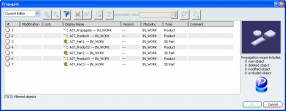Propagate | ||
| ||

#
Displays the number of each object according to its location in the hierarchical structure. In our example, "ajt_Product2" has been given the number "2" because it is the second reference in the hierarchy and its sub-elements are numbered as follows: "2_1" for the first sub-element, "2_2" for the second sub-element, etc.
This column also indicates if the reference and/or its aggregated objects are new or modified.
-

-
The reference and all its aggregated objects have not been modified.
-

- The reference is new or has been propagated as new.

The reference has been modified.

- The reference has been modified and cannot be propagated.

The reference is unchanged and aggregates one or many new or propagated as new objects.

The reference is unchanged and aggregates one or many modified objects.

The reference is unchanged and aggregates one or many new or modified objects.

The reference is unchanged and aggregates one or many modified objects that cannot to be propagated.

The reference is modified and aggregates one or many new objects.

- The reference is modified and aggregates one or many modified objects that cannot be propagated
![]()
Modification
Displays the propagation status.
-

- The object is to be propagated.

- The object has been manually excluded from the propagation scope.

- The object has been automatically excluded from the propagation scope.

At least one reference's aggregated object has been modified.

The object (which cannot be displayed as a reference) has been deleted.
![]()
Lock
Displays the type of lock, if any, applied to the object. The identity of the person who locked the object is displayed next to the Lock Mechanism.
-

-
The reference and all its aggregated objects are locked by you.

-
All the reference's aggregated objects are locked by you.

- The reference has been locked by you and at least one of its lockable aggregated objects is not locked.

- The reference is locked by you and at least one aggregated object is locked by someone else.

- The reference is locked by someone else and all its aggregated objects are locked by you.

The reference and at least one aggregated object are locked by someone else.

At least one reference's aggregated object is locked by someone else.